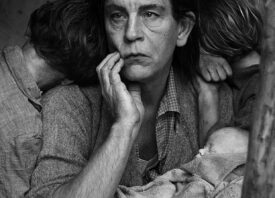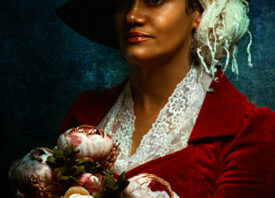Search this site
These intimate scenes will take you back to the Victorian Era


Tami Bahat’s photographic portraiture is at once unique and familiar: unique in its distinct approach to lighting and Victorian-era style, yet familiar in its visual cues, referencing the work of old masters such as Vermeer and Rembrandt.
The work in Bahat’s series, Dramatis Personae, is tied to the tradition of painting. In her piece The Painter, a seemingly conventional composition becomes quite complex upon further investigation, as a baboon takes center stage in a once traditional artist portrait. There is a subtle twist in each of Bahat’s photographs, quietly demanding the attention of the viewer.
Originally from Tel Aviv, Israel, Bahat currently lives and works in Los Angeles. Recently, her work has been exhibited at Lisa Sette Gallery, Phoenix, Van Rensburg Gallery, NYC, Diane Tanzer + Nicola Stein Gallery, Australia, and Catherine Edelman Gallery, Chicago, which is hosting her solo exhibition Past is Present.
In the exhibition, the vintage objects and props present within each photograph come out of the frame and into the gallery, creating a different kind of experience for the audience than is expected. The gallery space has been transformed into Victorian-era rooms, complete with DIY vintage wallpaper. It’s these small details that prompt Bahat’s photographs, and the exhibition as a whole, to come to life.
Here, Tami Bahat discusses the immersive elements of Past is Present, her process working with her models and animals, and how she achieves her painterly effect.

Did you always know you wanted to be a photographer? Do you have any formal training in the field?
“I don’t have a formal education in photography. However, my father was an art teacher. He would point out the nuances of lighting, expressions, shades, and shadows. He shared his love of art and the Old Masters with me, and that was something we certainly bonded over. I was very fortunate to learn from and be inspired by him on a daily basis. I knew from a very young age that I loved photography and portraiture. My love and affinity for the art form continued growing over time and I knew it was something I wanted to explore further.”

Tell us a bit about your series Dramatis Personae.
“I began creating this work in 2015. The majority of the models are family and friends who have little to no experience in front of the camera, which I love. I enjoy going into each shoot with concepts prepared but no set expectations. I always leave the door open for a bit of mystery and whatever they would like to explore and contribute. Many of the photographs also include live animals so I like to watch the relationship unfold from the moment the models meet them. The world created is all very beautiful and intriguing to me.”
The dramatic, chiaroscuro lighting in this series gives each photo an aesthetic like that of a painting. How do you achieve this effect?
“I shift the light depending on the scene and diffuse it accordingly. It’s all about creating a very specific mood and atmosphere and paying attention to the smallest of details. I’m extremely particular and work hard to stay present and adjust to whatever is happening in the moment.”

In your current solo exhibition Past is Presentat the Catherine Edelman Gallery, Chicago, props used in the making of your photographs are physically installed in the gallery. What inspired you to bring these elements into the exhibition? How do you think this changes the viewer’s experience when viewing your work?
“The idea is to create a unique experience for the viewer that invites them into this world. They can walk through someone’s bedroom and feel like a visitor in another time and place. It’s almost as if you could stand there patiently enough, the portraits and surroundings would start to whisper a story or two to you. I think they’re a great supportive element to the work.”

The feel of the exhibition Past is Present is very moody, reminiscent of painting from the Dutch Renaissance. The installations have truly created an atmosphere that transports you to a different time. What goes into the process of planning an exhibition that is as immersive as this, especially when you live in California and the exhibition is in Chicago?
“I have to express my gratitude to the staff of the Catherine Edelman Gallery. It was an honor to have these hard-working individuals completely invest their time and energy in my vision as an artist. It’s rare to be taken in with such a level of support from people who are as equally ambitious and want to create something distinct.
“In California, we built a model of the gallery to wrap our heads around how we would lay everything out in Chicago. I’ve always been able to walk through a space beforehand so this was very different for me. There were many discussions as to where each piece would be placed. We shipped out a truckload of furniture and once we arrived in Chicago the real work began with painting, stenciling, staging, hanging the work and gently placing quail eggs in a bird’s nest atop the mantle of the sitting room.”

Vintage frames as well as Victorian-style furniture and décor appear repeatedly in your photos and really shape the work that you do. What is it about this era that appeals to you, aesthetically or otherwise?
“I sense that I existed in these other times and connect to them so strongly. The frames and furniture have been there, too, so we just kind of reminisce like old friends.”
Where or how do you find the objects and/or props that you use in Dramatis Personae?
“I search extensively both locally and internationally. Anywhere from auction houses to estate sales to flea markets.”

When did you start incorporating animals in your photography? Where do you get these animals from?
“I started off with reptiles like snakes to Madagascar hissing cockroaches. From there, I jumped into more exotic animals. I’ve worked with great rescue organizations and phenomenal animal handlers. I love seeing these beautiful creatures treated with love and respect, especially those that have had a rougher go of things early on.”
If you could photograph any animal, what would it be and why?
“A giraffe and elephant. They’re simply magnificent!”
What draws you to portraiture? Do you personally know the subjects in your work?
“I remember being drawn to portraiture, even as a young child. I received a journal from my parents for one of my birthdays with a painting of a little girl on the cover and I was absolutely in love with it. Later as a teenager, when hiking with friends, I would document the people around me in the scene as opposed to all the nature around us. I’m drawn to understanding the human experience. Most of the people in Dramatis Personaeare family and friends who have never modeled before and I want their first experience in the art form to be positive. To explore and create something that’s never existed before is exciting.”

Often works with the simplest compositions are the most difficult to capture. Which photograph in your series Dramatis Personae proved to be the biggest challenge and why?
“I underestimated the speed of the armadillo in, Frank the Tank. The combination of how fast that little guy was while shooting in low light was challenging, but we still managed to get the shot, thank goodness!”
Who are your biggest artistic influences? Are there any photographers working right now whose work you find particularly interesting?
“Some amazing artists that come to mind that move me are Caravaggio, Vermeer, Rembrandt, Rodin, Marc Chagall, Yosl Bergner, Valérie Goutard, Sophie Favre and Antony Gormley. As far as photographers go, I really enjoy the works of Sally Mann, Diane Arbus, Richard Avedon, Joel-Peter Witkin, and Nadav Kander just to name a few. I also love jazz and cinematography and documentaries so my inspiration list could just go on and on…”




